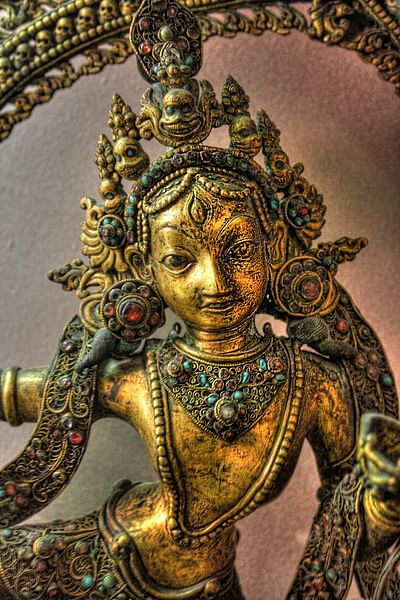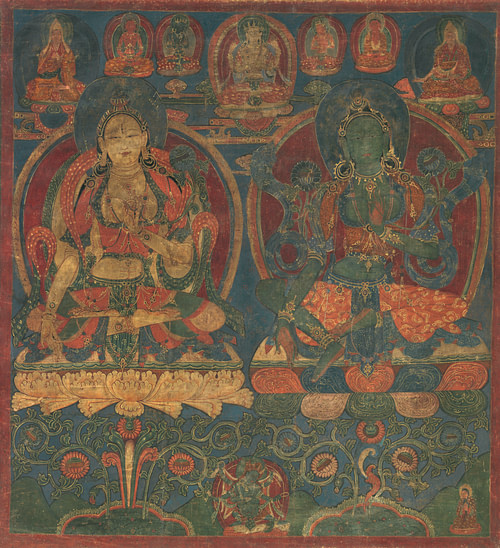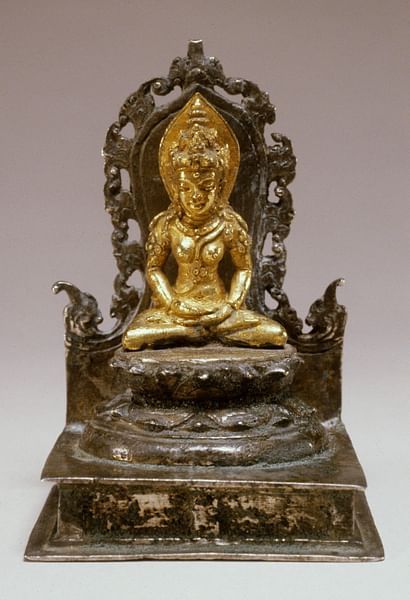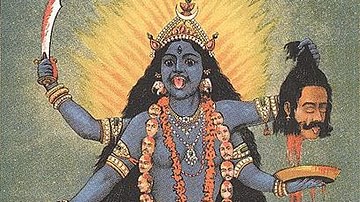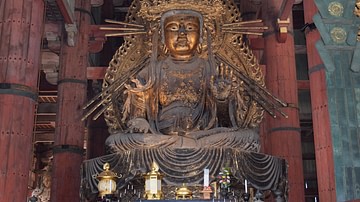
Tara is a female deity in both Hinduism and Buddhism who personifies compassion and offers salvation from the suffering of rebirth and death. She is thought to have been born of empathy for the suffering world and is regularly invoked for protection, guidance, and deliverance from difficult situations.
In Hinduism, she is the second of the ten Mahavidyas, avatars of the great Mother Goddess Mahadevi (also known as Adi Parashakti as well as other names). Adi Parashakti manifests as the trinity of goddesses Saraswati, Lakshmi, and Parvati, and the Mahavidyas are then more specific avatars of these three. She is an ishta-devi, one’s preferred female deity (the male version being an ishta-deva), as Hinduism is henotheistic (a belief in a single deity with many manifestations). Tara is a manifestation of Parvati as a devoted mother caring for and protecting her children and is thought to be the mother of Sakyamuni Buddha (l. c. 563 - c. 483 BCE) who is understood in Hinduism as an avatar of the god Vishnu. Her major cult center is Tarapith in West Bengal.
In Buddhism, Tara is a savior deity (savioress) who liberates souls from suffering. She is recognized as a bodhisattva ("essence of enlightenment") in Mahayana Buddhism and as a buddha and the mother of buddhas in Esoteric Buddhism, particularly Vajrayana Buddhism (also known as Tibetan Buddhism). According to one origin tale, she emerged from the tear of the bodhisattva Avalokitesvara who cried when looking upon the suffering world. She is therefore associated primarily with compassion but can take on many forms to help and protect her devotees, including a wrathful deity similar in appearance to Kali, the Hindu goddess of death and transformation.
The first fully attested textual evidence of Tara’s worship comes from the 5th century CE, but recognition of the goddess is much older as she is mentioned in the Rig Veda (c. 1500-1100 BCE) and was known during the Vedic Period (c. 1500 - c. 500 BCE). She is also associated with the goddess Prajnaparamita from the Buddhist work Perfection of Wisdom, an anthology composed between c. 50 BCE - c. 600 CE. She is also referenced in the Bardo Thodol (The Tibetan Book of the Dead) dated to the 8th century CE.
Her name means "savioress" in Sanskrit but has also been translated as "star" and she is invoked for guidance in life generally and, specifically, by those who feel lost and are having difficulty finding their way. Like a star, Tara is thought to provide a single point of light one can navigate by. She is associated with mother goddess figures in the Buddhist schools of many different cultures and is probably best known to a Western audience as Guanyin, goddess of compassion, from China. She remains one of the most powerful and popular goddesses in Esoteric Buddhist schools, and her worship, in both Hinduism and Buddhism, continues in the modern era.
Possible Historical Development
It is unclear when the veneration of Tara began, but she is associated with the Shakti sect of Hinduism which worships the feminine divine principle of the Mahadevi as the source of all creation rather than the male principle of Brahman. Shakti does not deny the male principle, recognizing the importance of both male and female, but elevates the Mahadevi to the most prominent position. It is likely this sect was established by the Indus Valley Civilization (c. 7000 - c. 600 BCE) and influenced the development of the popular sects of Vaishnavism (centered on the god Vishnu) and Shaivism (emphasizing Shiva). All three recognize the importance of balance between male and female energies as well as the elevating effect of personal devotion to the deity of one’s choice.
As noted, textual evidence for Tara comes first from the Rig Veda and physical evidence of her worship from her temple at Tarapith, established in c. 1225 BCE. The site of Tarapith was formerly (and part of it still is) a charnel ground where corpses were left to decompose (or were cremated) as part of mortuary rituals. These grounds were frequented by religious ascetics known as siddhas as well as those who were considered even more spiritually advanced known as mahasiddhas ("great" or "perfected" siddhas) who claimed to be able to commune with the eternal spirits and powers of the place as well as the souls of the dead.
Tarapith (as the name makes clear) is a pith (plural, pitha, "abode" or "seat") of Tara, a place where her power and presence are most accessible. As she is associated with death and symbols of mortality such as skulls in some of her forms, she may have been developed by mahasiddhas sometime before 1225 BCE as their ishta devi, probably as part of the Shakti sect. Whatever part purely religious considerations played in this, their devotion to Tara would have self-identified the group, differentiating it from others in the Shakti sect, and helping to develop a specific form of worship of the goddess.
Tara in Hinduism
There are several origin tales for Tara in Hinduism but one of the best-known concerns the goddess Sati, consort of Shiva. Sati’s father, Daksha, insulted Shiva by not inviting him to participate in a sacred fire ritual. Sati felt personally responsible for this slight and, unable to live with the shame of her father’s actions, threw herself into the fire during the ritual. Shiva went mad with grief and, to help him, Vishnu gathered up the parts of Sati’s body and scattered them across India. Wherever a part fell, it bloomed into a manifestation of another goddess, and so Sati continued to live through them. Each of these sites was then recognized as a pith – the home or "seat" of a particular goddess.
One of Sati’s eyeballs is said to have fallen at Tarapith, making that her seat, and the temple was later raised in her honor. The site was obviously associated with Tara before the construction of the temple and especially its charnel grounds where the siddhas and mahasiddhas would engage in their rituals. Scholars Robert E. Buswell, Jr. and Donald S. Lopez, Jr. comment:
[Pitha] appear commonly in scenes from the lives of the mahasiddhas. Many of the sites can be linked to geographical locations on the Indian subcontinent, although some remain unidentified, and the location of others shifts according to different traditions. They are considered, however, to form a network, both in the external world and inside the body of the tantric practitioner…In both their external and internal forms, the pitha are presumed to form a mandala (647)
The mandala (Sanskrit for "circle") is a geometric shape expressing spiritual meaning and interpreted by those who view it as a kind of map of their inward journey. It can also be understood as a representation of Divine Order, which is how it would be understood regarding the pitha. Hinduism is known to adherents as Sanatan Dharma ("Eternal Order"), and the universe is understood to operate according to the rules of that order created and maintained by Brahman. When Vishnu scattered the parts of Sati’s body, therefore, Divine Order directed where they would land for its own purposes; these purposes were later understood as the creation of a mandala to aid human beings in their spiritual work.
The pitha became pilgrimage sites and Tarapith one among many (51, according to some traditions, 12, 24, or 32, in others). Tarapith honors Tara in her form as compassionate mother while also recognizing her fierce protective nature. Accordingly, blood sacrifices were made (and still are in the present) to the cult statue of the goddess inside the temple. Participation in the rituals at Tarapith are believed to be restorative, curing illnesses (both physical and psychological) and even bringing the newly dead back to life.
Tara in Buddhism
Tarapith is a Hindu temple and, specifically, of the Shakti sect, but it is honored by Buddhists who recognize Tara as not only the mother of Sakyamuni Buddha but of all buddhas before and after him. She is said to have been born of the compassion of the bodhisattva Avalokitesvara (also known as a buddha) when he wept over the suffering world. Avalokitesvara is an important figure in both Hinduism and Buddhism and, in the latter, is associated with the sacred number 108 as he is said to have 108 avatars which appear to people in their various forms to help them most effectively.
In Tibetan Buddhism, he is known as Chenrezig who, upon looking down upon the world from the summit of a mountain, saw how people endlessly suffered through ignorance, which trapped them in their own fears and bound them to the cycle of rebirth and death (samsara) on which they would suffer eternally unless awakened. His tears formed a pool at his feet which expanded into a lake, and, at its center, a lotus appeared and then opened, revealing Tara in her complete form and power. She is therefore regarded as the female embodiment of Avalokitesvara/Chenrezig who himself is understood as the embodiment of compassion and compassionate wisdom.
Modern-day scholars continue to debate whether Tara emerged first in Hinduism or Buddhism which may seem a senseless argument since it is clear, historically, that Hindu texts and the temple honoring her predate the establishment of Buddhism. Buddhists, however, claim an eternal spiritual history for their belief system comparable to that claimed by Hinduism, and according to this understanding, Avalokitesvara, and therefore Tara, predate institutionalized Hinduism. In this Buddhist cosmography, there are many different world systems operating in different spheres of time simultaneously, and in one of these, according to another origin tale, Tara was born.
According to this story, there is a young woman named Yeshe Dawa ("Wisdom Moon" or "Moon of Primordial Awareness"), daughter of a king, who lives in the realm of Multicolored Light and makes sacrifices for centuries in her pursuit of wisdom until she is taken on as a student by The Drum-Sound Buddha, the Buddha of that world, who instructs her in the path of enlightenment. Having attained a high degree of spiritual insight, she takes the vow of the bodhisattva and is blessed by the Buddha. The monks rejoice at her accomplishment and tell her she should now pray to be reborn as a male so she can advance further in her next life. Wisdom Moon rebukes the monks, noting:
Here, no man, no woman,
No I, no individual, no categories.
"Man" or "Woman" are only denominations
Created by confusions of perverse minds in this world. (Mull, 8)
She then vows to always be incarnated as a female for as long as she continues in the realm of samsara because there were many men who served as role models of the enlightened path but, owing to human ignorance and male arrogance, few women. She continued to advance in spiritual wisdom, power, and compassion, meditating continuously, and by so doing she freed infinite numbers of souls from the suffering of rebirth and death, finally becoming the goddess Tara, the savioress, always ready to respond to the cries of those who call upon her.
Tara as Symbol of Transformation
She is believed to quickly respond to adherents who recite her mantra, "Om Tare Tuttare Ture Svaha" (pronounced Ohm Tahray Too-Tahray Turay So-ha), which cannot be literally translated but essentially praises the goddess for her role as savior and asks for her speedy assistance. The mantra is often chanted or sung to musical accompaniment and repeated during private meditation or public worship. The mantra is thought to not only bring Tara into the physical and spiritual presence of the one reciting it but also encourage growth and change.
Tara herself can manifest in 21 forms and so embodies the value of transformation. Aside from her mantra, adherents also recite the prayer known as Praises to the Twenty-One Taras which, names each of her forms, what that form protects against, asks for her help, and praises her for salvation from rebirth and death. Her most popular forms are:
Green Tara: known as "Tara Who Protects from the Eight Fears" (lions, elephants, fire, snakes, thieves, water, imprisonment, demons), representing protection from misfortune generally. Green Tara is the most often depicted and best-known image of the goddess.
White Tara: not always depicted as white but recognized by eyes on the palms of her hands, soles of her feet, and a third eye on her forehead symbolizing her attentiveness. The White Tara embodies compassion and is invoked for healing (physical, spiritual, and psychological) and the hope of longevity.
Blue Tara: the wrathful aspect of the goddess, often depicted with many arms like the Hindu goddess Kali for whom she is sometimes mistaken. Blue Tara is the personification of righteous anger that destroys painful illusions and awakens one to spiritual truths. She is invoked for good fortune in any enterprise, protection, and spiritual progress.
Red Tara: sometimes depicted with eight arms, each hand holding a different object associated with warning against and protection from danger. She is associated with the attraction of positive energies, spiritual focus, and psychological/spiritual victory. She is often invoked by those trying to break bad habits.
Yellow Tara: sometimes depicted with eight arms, hands holding jewels or a single hand holding a jewel believed to grant wishes. She symbolizes prosperity, physical comfort, and wealth and is always either a shade of yellow or gold. She is invoked for financial gain but also for the granting of wishes having to do with the welfare of one’s family, friends, and oneself.
Black Tara: associated with personal spiritual power, she is depicted with an open mouth and wrathful expression as though yelling, seated on a sun disc sometimes alive with flames, holding a black urn containing the essential forces necessary to overcome negative energies and destructive forces, whether internal or external. She is invoked to clear obstacles one has created or those placed in one’s path by others or circumstance.
All of her forms are transformative in nature and, as noted, encourage transformation in adherents. Tara continues in this role after one’s death as she serves as a protector and a guide in the afterlife. In the work known as Bardo Thodol ("Liberation Through Hearing in the Intermediate State"), better known as The Tibetan Book of the Dead, Tara is invoked for protection (Book I, Part II, 5th Day) and called on in the concluding Prayer for Guidance. In the prayer, she is invoked in her various forms and colors to assist the soul in finding peace.
Whatever her color or form, she is always shown as a young, slim, healthy woman ready to spring into action on behalf of her devotees. Tara’s ability to address the needs and concerns of virtually every aspect of a believer’s life makes her among the most popular, if not the most popular, goddess in the Buddhist pantheon in the present day, just as she has been regarded in the past.
Conclusion
Adding to her popularity is her appeal to women who recognize they are just as capable of spiritual enlightenment as males. Theravada Buddhism and some other schools of Buddhist thought maintain that one must be incarnated as a male to advance to the highest spiritual plane and free oneself from rebirth and death, but Tara, in the story of her enlightenment in the realm of multicolored light, makes clear that "male" and "female" are illusory designations clung to by shallow minds unable to recognize the true nature of reality.
Scholar Allison Mull notes how Wisdom Moon vows to continue to be incarnated as a woman to help all sentient beings appearing in female form recognize the divine light in themselves and encourage it to grow. Mull notes:
It is this vow that Tara would later become known for; her insistence on the error in designations, and her resolve to lead beings on the higher path of realization…Liberating an infinite number of suffering beings both day and night, Wisdom Moon came to be known as "Savioress" or, in Sanskrit, "Tara" (8)
Some Buddhist schools (Mahayana Buddhism and Vajrayana Buddhism, among others) have embraced Tara’s vision and vow and have made use of it in attracting and ministering to women. Male and female Buddhist monks participate in veneration of Tara in the present day as well as millions of lay Buddhists and Hindus around the world who continue to call on Tara to assist them in maintaining balance, embracing transformation and change, and finding their footing in an often-challenging world.


